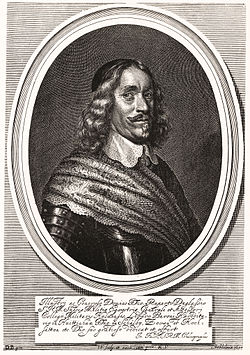Background
In the spring of 1658, Swedish attention turned towards Courland. The Swedish king, Charles X Gustav, no longer wanted to use diplomacy and Robert Douglas was ordered to conquer the Duchy. Before the invasion of Courland began, the Swedes retook the Livonian fortresses that were still under Lithuanian occupation. [2] [3] A reason for King Charles wanting Robert Douglas in Livonia was the need to deal with Courland. the Duke of Courland, Jacob Kettler, was an efficient entrepreneur who had managed to establish colonies and tried to stay neutral in the war between Sweden and Poland–Lithuania, assembling an army of 14,000 troops in order to make its neighbors respect its neutrality. [4] [5] The ports of Courland were also a part of Charles' plan to take control of the entire Baltic shore. [4]
Swedish plan
The Swedish plan went as follows: The Swedes would invade Courland, and force the Duke to hand over Mitau and Bauske. If the Duke were to refuse, he was to be arrested and all Courlandish ships were to be captured. When this was done, the entirety of Courland was to be quickly occupied, the Swedish army was also to be supplied by the countryside. [6]
Invasion
In late August or early September, Robert Douglas began his march into Courland with 1,652 [2] –1,700 [4] infantry and 2,800 [4] –3,721 [2] cavalry. The invasion involved deception, since at first Douglas informed the Duke that they were only marching through his territory on an expedition to northern Lithuania. [4] [2] [7] The duke, suspicious but not in a position to protest, admitted entry to the Swedish army. [6] Because of the Duke's vigilance, Douglas had to temporarily postpone the attack on Courland's capital, Mitau. [4] Instead, Douglas continued deceiving the Duke, and marched his army into Lithuania, soon afterwards, however, the Swedes returned into Courland. This time, they marched straight towards Mitau. [8] [4] To alleviate any worries that the Duke may have had, Douglas began negotiations for supply deliveries to his army and the Riga garrison. His entry into Mitau to negotiate allowed him and several officers to survey its defenses. [4]
The town itself seemingly did not pose any particular problem, but to capture the castle, the Swedes needed further preparations. Realizing that more infantry was needed to capture the castle, Douglas again postponed his attack. The negotiations between Sweden and Courland continued. The duke found himself forced to accept Swedish security guarantees in exchange for Sweden's acceptance of Courland's neutrality. [4] Meanwhile, Douglas continued final preparations for the surprise assault on Mitau, all while he claimed that Lithuania was the real target. Because of heavy rain and high water levels, preparations took longer than expected. [4] Claiming that a number of his soldiers were sick and had to be sent to Riga, Douglas borrowed several river barges from the Duke. [4] [2] [7]
On the 9th of October, the Swedes finally moved on Mitau, Major General Nils Bååt with a force of 500 musketeers embarked on the fleet of barges. [4] [2] The barges would float with the stream so to avoid any unnecessary noises. When they reached their destination, the men would disembark and carry out a surprise attack at night on Mitau Castle. [4] [2] Simultaneously, Colonel Jacob von Yxkull would lead 400 soldiers in an assault on the town gates. He would also block enemy reinforcements from reaching them. [4] Colonel Otto Wilhelm von Fersen would also bring a small cavalry force to eliminate the observation post which the Duke had deployed outside the town. [4]
The Swedish assault was successful, Courlandian opposition was minimal, and Jacob's 14,000 untrained peasant troops were unable to defeat the well trained Swedish army. [5] In the morning of 10 October, all of Mitau had been occupied by Sweden, and the Duke was placed under arrest alongside his family, and court. [4] [2]
This page is based on this
Wikipedia article Text is available under the
CC BY-SA 4.0 license; additional terms may apply.
Images, videos and audio are available under their respective licenses.
